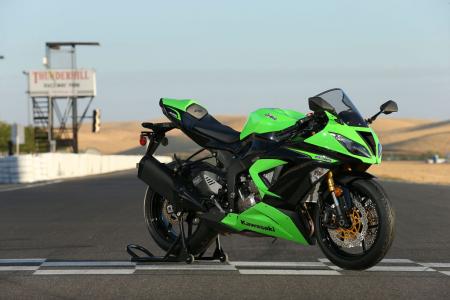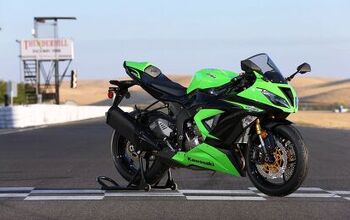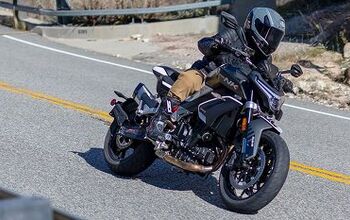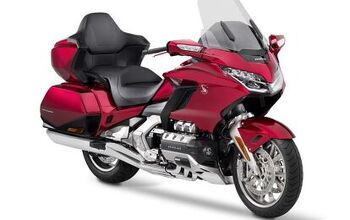2013 Kawasaki Ninja ZX-6R Review - Motorcycle.com
It’s hard to believe a decade has gone by since the 636cc Kawasaki ZX-6R first came to our shores. The beefed-up middleweight shook up the category with its displacement advantage over its rivals, and with the 600cc ZX-6RR variant being sold alongside, both racers and street riders were happy. But in 2007, after four years of success, Team Green stuck with tradition and axed the 636 from its lineup to continue with a 599cc version.
However, with many manufacturers focusing on literbike updates lately, the middleweight category has remained relatively stagnant, save for a freshened up Suzuki GSX-R600 in 2011, and, of course, MV Agusta’s beautiful F3. Known for shaking up the status quo, Kawasaki is looking to jolt some life back into the class with the 2013 ZX-6R. The magic number behind the new ZX: 636.
Yep, Kawi has brought back the successful formula last seen in 2006, adding 37cc more displacement to the existing 6R engine, resulting in a motorcycle that’s powerful on track and flexible on the street. The interesting twist, however, is a conspicuous omission of its 600cc ZX-6RR counterpart. More on that later.
After seven years away, one might wonder why bring the 636 back now? “Since 2007, when the ZX-6R went back to 600cc, the bike was focused on the track rider. Now, engineers wanted to appeal to a broader range of riders,” says Kawasaki Product Engineer Yoshi Sakakihara.
What’s Old Is New Again
In order to achieve the increased displacement, Kawasaki engineers started with last year’s 599cc engine and increased its stroke 2.6mm to 45.1mm (compared to 42.5mm) while retaining an identical 67mm bore. But why stop at 636cc? If Kawasaki is looking to be different and think outside the lines, why not go even bigger?
“We wanted to maximize displacement without increasing bore diameter,” says Sakakihara, adding that a larger bore would result in a wider chassis and a heavier-feeling motorcycle due to the gyroscopic effects of the bigger pistons and running gear.
A number of internal improvements to the engine were made to accommodate the bump in power. Revised Intake and exhaust ports help meet the power characteristics Kawasaki was aiming for, while dual injectors are ditched in favor of single units. This not only saves weight, but also accounts for the 11% increase in airbox volume.
Each injector sprays a super-fine 60 microns and together deliver a 20% higher fuel flow rate compared to last year, negating the need for twin injectors, says Kawi. Intake cams receive 3.0 degrees more duration, while both intake and exhaust cams get slightly more lift. Compression ratio is cut a smidge to 12.9:1, from 13.1:1, while pistons and connecting rods are reshaped and strengthened to cope with the extra power. The rods are 1.5mm shorter to offset the longer crank throws.
All four header pipes are now connected via cross-over tubes intended to increase low- and mid-range torque. Previously, only headers 1-2 and 3-4 were connected. The silencer and sub-chamber combination meets both U.S. noise and Euro 3 emission regulations, meaning regardless of which side of the Atlantic you’re on, the ZX-636 will be tuned to make the same power. Some might recall previous generations of ZX-6R shipped to the States were tuned differently to meet U.S. noise regulations, ultimately making less power than its European counterpart. Those days are gone.
Harnessing all this power is a new aluminum slipper clutch from F.C.C. claimed to be 700 grams lighter than its predecessor. Its assist function provides a lighter feel at the lever, while also shaving the number of clutch springs needed from six to three. The slipper function helps keep the rear wheel from hopping or locking during aggressive downshifts.
KTRC, or Kawasaki Traction Control, makes its first appearance on a Kawasaki middleweight sportbike. Featuring three different settings (four including off), the ECU monitors wheel speeds, and throttle/gear positions once every five milliseconds to determine whether to intervene. Mode 3 provides the most intrusive intervention, practically limiting any wheel slip, perfect for low-grip situations. Modes 1 and 2 are intended to maximize acceleration during track or aggressive street riding on dry, non-slippery surfaces.
Should intervention be needed, Modes 1 and 2 rely on manipulation of ignition timing to dial back power. In addition to this, Mode 3 also cuts fuel and air to keep the rear tire from spinning up. Two power modes are available now as well.
Full mode unleashes all of the 636’s power, while Low mode delivers a milder throttle response starting at approximately 10,000 rpm, ultimately delivering 20% less top-end power than Full mode. Low rpm performance is identical. KTRC and the selectable power modes are easily manipulated via a thumb toggle on the left switchgear, and the two functions operate separately from each other, meaning there are up to eight different combinations to choose from.
On the chassis front, frame and swingarm are carried over from last year’s model, though with revised mounting points for the new bodywork. The big news this year is Showa’s new front suspension. Officially called the “Separate Function Fork - Big Piston,” consider it the latest iteration of the Big Piston Fork seen on last year’s bike.
The SFF-BP uses springs in both forks but locates the spring preload adjuster on the left cap while the compression and rebound valving are in the right leg with its adjuster atop. The biggest benefit of this new system is having all the adjusters atop the fork legs, negating the need to get on your knees to reach the fork bottoms to make setting changes. A fully adjustable Showa shock is located in the rear, now with a slightly longer and marginally softer spring compared to last year. Kawi says this is to provide more compliance over bumps.
Another first for Team Green, the ZX-6R gets monobloc calipers courtesy of Nissin. The four-pot, radially mounted units are a total of 90g lighter than last year’s two-piecers and provide increased rigidity. They also feature 32mm pistons throughout, whereas the outgoing calipers used a combination of 30mm and 32mm pots. They bite on 310mm x 5mm rotors – 10mm larger and 1mm thinner than before. What this means is firmer, more consistent braking power you can feel at the lever.
KIBS, or Kawasaki Intelligent Anti-Lock Brake System, is an available option on the ZX-636, though none were available to test, as they were still in a crate bound for these shores as of this test. KIBS automatically modulates brake pressure to minimize ABS intrusion and the resulting pulsing at the lever. It uses ECU tuning to help suppress (not eliminate, Kawi was quick to point out) rear-wheel lift during hard braking.
On the styling front, Kawasaki designers enlarged the ram-air duct and gave the front fairing a more angular, aggressive profile compared to last year. This combined with slight rear cowl tweaks, flush-mounted front turn signals and numerous blacked-out panels account for the new bike’s appearance. All told, the 636 gains 2.2 pounds over its predecessor, coming in at a claimed 423.4 pounds, ready to ride. Add another 4.4 pounds for ABS.
The Big Question
The obvious omission from Kawasaki’s lineup this year is a 600cc, ZX-6RR variant for racing purposes. While this may come as a surprise to some people, the reason for this is quite simple. According to Kawi reps, during the four-year span from 2003 - 2006 when the ZX-6R and ZX-6RR versions were sold side-by-side, the 636 far outsold the 600. So from a sales perspective, the decision was simple.
But what about racers, you ask? Since Kawasaki doesn’t field a factory effort in AMA Pro Road Racing, Team Green doesn’t feel the need to import a 600cc ZX-6RR to America. In addition, most, if not all, club racing organizations had a class the 636 was competitive in seven years ago, so it’s reasonable to expect this to happen again.
In reality, only those few truly hoping to race a Kawasaki middleweight in AMA will be let down. However, the 2012 ZX-6R will continue to be sold alongside the new 636 in Europe for homologation purposes in World Supersport, receiving little other than new graphics.
Track Dominance
To prove the new 6R’s track prowess, Kawasaki invited journalists from around the world to Thunderhill Raceway in Northern California. The twisty, undulating track is one of the premier racetracks in the state and the perfect venue to put the 636 through its paces.
Ergonomically, the new model feels virtually identical to its predecessor, which shouldn’t come as a surprise considering they share the same frame and subframe. Reach to the bars doesn’t seem overly aggressive, especially compared to more track-oriented competitors like the Yamaha YZF-R6. Pegs aren’t too high, and the seat provides plenty of room to move around. Overall, the rider triangle is on the roomier side for a sportbike.
Twist the throttle and the resulting power increase from the bigger engine makes the 636 feel more like a modified 600. That’s saying a lot when you consider the previous ZX-6R’s motor was already the class leader, as we found out in our Supersport Shootout last year.
The bump in power is felt throughout the rev range, making itself especially noticeable exiting corners where the extra torque helps the ZX leap out of turns with more urgency than any 600. Power tapers off just shy of its 16,000 rpm redline, 500 revs shy of last year’s bike. Clicking the next gear early is preferred to revving it for all she’s got.
Playing with the power modes, in Low below approximately 10,000 rpm power is unchanged, but past the 10k mark throttle response is noticeably slower. Revs don’t climb as fast and ultimately top-end power is down as well. For the rider looking to learn proper throttle control, Low mode would be the place to start. However, for maximum enjoyment, Full power mode is the place to be.
With the switch to single injectors I was curious if low-speed fueling would be affected, as this arrangement can result in abrupt throttle response at low speeds. Kawasaki engineers claim the increased fuel flow rate combined with the super fine spray from the injectors negates the need for secondary injectors. Sure enough, I was pleasantly surprised on the track and street as the fueling felt perfect for the conditions with no perceivable hiccups.
Thunderhill’s sweeping turn two is an excellent setting to experiment with traction control, as its exit encourages the rider to “steer with the rear.” In traction control level 3, or the most intrusive setting, the slightest hint of a slide triggered intervention and killed any drive. Definitely not fun at the track.
Level 2, as expected, allows more tire slip but is still rather intrusive. Remarkably, I couldn’t feel TC2 intruding until switching to TC1. Exiting turn two, my normal procedure is twisting the throttle to the stop. Doing so in TC2 delivered lackluster power delivery with no audible clues it was cutting in, unlike the abrupt TC intervention I’ve experienced in the past on other motorcycles.
In TC1 the ZX would exit with much more ferocity, and it was then I realized how much TC2 was actually intervening. Needless to say, I was surprised at how far electronics have come in such a short time. The Bridgestone R10 tires used for the track portion of our test provided excellent grip, control and predictability. Some faster riders preferred turning off the TC, but personally, having the TC safety net gave me the confidence to open the throttle earlier and harder.
With the same chassis as last year, agility and feedback is understandably similar. Direction changes are made quickly, and after a few minor tweaks to the rear suspension, confidence while leaned over is superb. High praise goes to Showa’s SFF-BP, as I didn’t need to make a single change to it throughout the day. Front-end compliance was spot-on.
Speaking of high praise, the new Nissin monobloc calipers and 310mm discs get top marks for power, confidence, feel and consistency throughout the day. T-Hill’s hard braking zones were no match for the Nissins, as whenever I reached for the lever it responded with authoritative stopping power time after time with excellent communication, affording me the confidence to brake to the apex.
Street Flexibility
According to Kawasaki surveys, almost 80% of ZX-6R owners ride their bike only on the street. So it makes sense, as Sakakihara stated earlier, for Kawi engineers to make the 636 appeal to a wider spectrum of riders than just racers. Hence a street ride through the winding roads of Lake Oroville after our trackday is only appropriate.
Straight away, the bigger engine means less clutch work when leaving from a stop. A shorter first gear makes launches easier, too. The healthy low- to mid-range power allows you to be lazy with shifting compared to other 600s, meaning carrying a higher gear through sections is possible. My particular test bike didn’t seem to have low-speed fueling issues, though some journos reported surging around 6000 rpm.
Usually smooth, freshly paved roads are a blessing during street rides, but unfortunately, they also limit the amount of suspension testing possible. However, over the few rough patches we encountered, both ends of the ZX felt compliant. Bridgestone S20 tires specifically designed with input from Kawasaki come standard. Performance is impressive, as they come up to temp quickly, have good grip for a spirited street ride and provide good bump absorption and feedback.
Ergonomically the roomy rider triangle noticed at the track is comfy on the street. An acceptable amount of weight is placed over the wrists without too much strain on the lower back. Wind flows comfortably over the shoulders with negligible helmet buffeting. View from the mirrors is rather generous as well.
Clearly the demands for the street aren’t nearly as punishing as the track, but braking performance is still impressive, exhibiting the same traits mentioned earlier. The F.C.C. slipper clutch provides very light pulls at the lever, and only struggles with locking during extreme downshifts. Say, fifth to second.
Conclusion
Save for a few exceptions, it’d be fair to say the middleweight category has been a little bland lately. The Kawasaki ZX-6R with its return to the 636cc formula is just the jolt the middleweight class needs. It provides the power boost both track riders and canyon carvers crave, with sophisticated electronics, capable suspension and top-notch brakes sure to make anyone faster and safer.
However, this comes at a cost. At $11,699 (add another $1000 for ABS), the 6R is more expensive than its Japanese and British rivals. And a 2012 GSX-R 750 retails for $12,199 and is clearly more powerful. Though, without doubt, the ZX-6R’s value-per-dollar ratio is highest among the middleweight supersport group. So as long as you’re in the middleweight market and aren’t looking to race in AMA, the ZX-636 makes a strong case for king of the class. Of course, now we’ll have to put them together to be sure...
Related Reading
2013 MV Agusta F3 675 Street Review
2013 MV Agusta F3 675 Review - Video
2012 MV Agusta F3 675 Review
2011 Supersport Shootout - Street [Video]
2011 Supersport Shootout - Track [Video]
2011 Middleweight Sportbike Shootout - Street [Video]
2011 Middleweight Sportbike Shootout - Track [Video]
2011 Suzuki GSX-R600 Review
2009 Honda CBR600RR C-ABS Review
2009 Kawasaki ZX-6R Review
2009 Kawasaki ZX-6R vs. Triumph Daytona 675
2008 Yamaha R6 - First Ride
More by Troy Siahaan











































Comments
Join the conversation